Mailchimp is synonymous with effective and simple email marketing campaigns. They own most of the industry, nearly 68% of the market, while comparative companies barely own 10% each at the most.
Their dominance as an email marketing tool is apparent. But does this make them the most appropriate solution for everyone?
In this article, you’ll learn more about what makes MailChimp dominant. You’ll learn about where it excels, where it struggles, and how you can use it most effectively in creating your email lists.
A quick overview – what is Mailchimp?
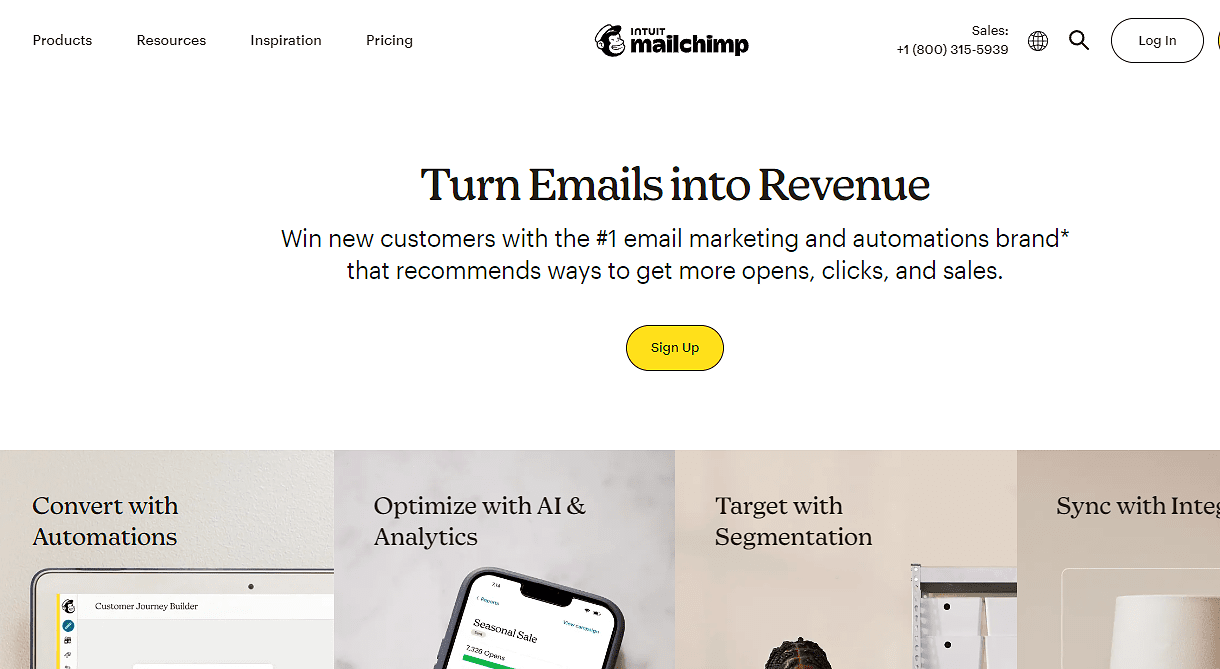
Mailchimp boasts its claim of being an all-in-one email marketing platform for small businesses. It was founded in 2001, growing from its Atlanta-based offices to more locations in Brooklyn, Oakland, and Vancouver.
Ben Chestnut and Dan Kurzius founded the company. The duo initially created a web design agency called the Rocket Science Group. At the time, Mailchimp was a single aspect of this growing business.
During this growth period, the company shifted its focus from big corporate clients to small businesses. In capitalizing on this opportunity, Mailchimp secured a hefty portion of the industry.
It also helps that the company is owned by Intuit, which is known for providing a wide range of small business products. With this in mind, Mailchimp has a strong backing of experience in small business services.
The Pros and Cons of using Mailchimp
Below, you’ll see a quick review of the advantages and disadvantages of using Mailchimp.
Pros
It has a free plan you can use to get started.
Design tools are beginner friendly and easy to use.
24/7 live chat support.
Marketing newbies will find it easy to track campaign results.
Customer relationship management tools are simple and handy.
It is easy to automate email marketing campaigns.
Mailchimp has over 300 integrations.
Cons
The free plan limits you by the number of subscribers and daily sends
Paid plans can get expensive quickly due to limited subscriber counts.
Design options are somewhat limited (especially on landing pages)
Limited support for free customers
Your automation features are limited on the lower pricing tiers
Mailchimp Pricing and plans comparison – how much does Mailchimp cost?
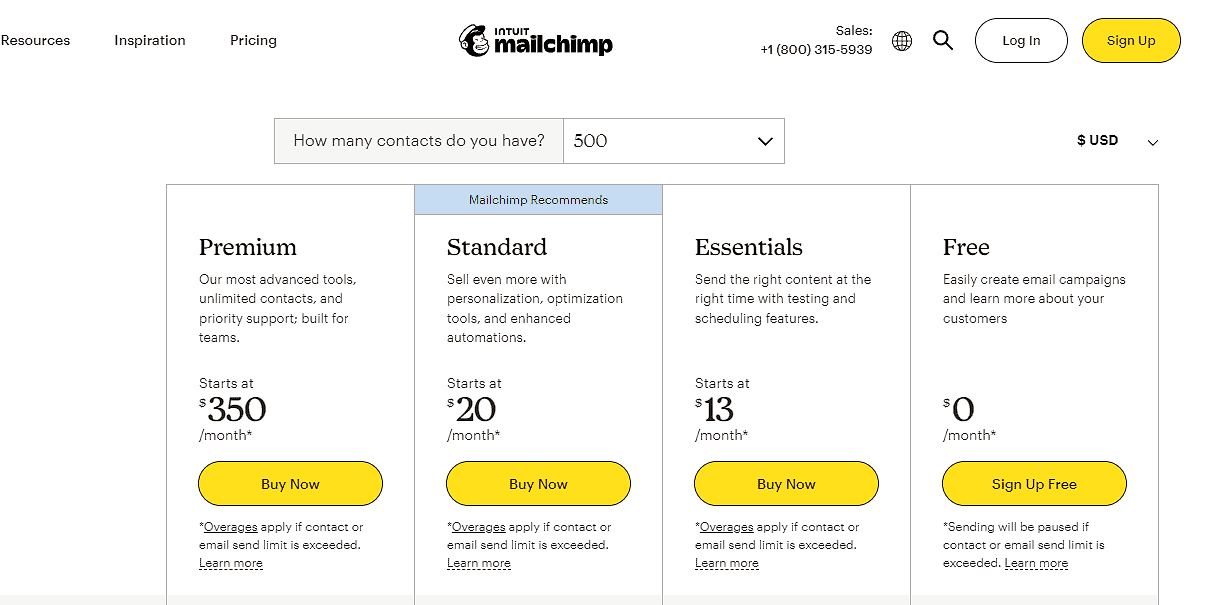
When looking at Mailchimp’s pricing options, you’ll find a lot of flexibility. There are four different plans you can choose from.
Free plan
Mailchimp’s free account allows you to check out the platform. The free plan has some problematic limitations, only giving you 500 contacts and 2,500 monthly email sends.
Here’s a breakdown of other features you get with this plan:
Features of the free plan
One seat
Email support for the first 30 days
Pre-built email templates
Integration support
Basic reporting and analytics
Creation of forms and landing pages
You can import custom graphics
Long-time free users might recall that Mailchimp used to support 2,000 email subscribers on the free plan. The reduction in contacts makes the free version less useful for businesses just starting with email marketing.
Essentials plan
The essentials plan starts at $13 per month for 500 contacts. You can pay approximately $13 additional per month if you want support for more connections.
Contact numbers go from 500 to 1,500 to 2,500. But you can’t exceed 50 thousand contacts without paying for the standard or premium plans. Paying for more contacts also provides you with more monthly email sends.
Here are the additional features you can get:
Features of the essentials plan
From 5 to 500 thousand monthly emails sends
Support for three users
24/7 email & chat support
You can remove Mailchimp’s branding
A/B testing features
Email scheduling
Building automated email chains
Standard plan
The standard plan starts at $20 per month for 500 contacts. You can pay up to $700 per month for up to 100 thousand contacts.
Below is a breakdown of features you can get with this:
Features of the standard plan
From 6 thousand to 1.2 million emails sends
Support for up to five seats
Pre-built customer journeys (email chains)
Custom-coded templates (can include HTML)
Send time optimization (pinpoints the best time to send emails)
Predictive segmentation (segments customers based on their likelihood to respond)
Content optimizer (Recommendations to improve emails)
Dynamic content (lets you keep email styles while switching the content)
Campaign manager (lets you streamline multiple campaigns in a single view of results)
Premium plan
The most expensive plan is the premium plan. It starts at $350 per month for 500 contacts. You can also pay up to $1,510 monthly for 200 thousand contacts.
The premium plan lets you exceed this number, but you need to contact their sales team to find out how much it costs.
Here are the extra features you get with this platform:
Features of the premium plan
Multivariate testing (lets you test eight variations of the same campaign and their results)
Comparative reporting (Compare the effectiveness of different campaigns and segments)
Advanced segmentation (Provides unlimited conditions for your segments)
Assisted onboarding (You get to work with a member of Mailchimp’s staff to get started)
In this Mailchimp review, we won’t be focusing on the premium features of this online marketing tool. Because this review is geared toward small businesses and solopreneurs with limited budgets, you’ll see excerpts from the lower-tier plans.
Optional website plans and tools
A lesser-known aspect of Mailchimp’s offerings includes the ability to build an entire website. Much like the plans for creating email campaigns, you can also get a free version.
Its website building plans are broken into three categories:
Website builder plans – quick pricing comparison
Free – It requires a 2% transaction fee (plus Stripe processing fees)
Core – A 1.5% transaction fee (plus Stripe)
Plus – A 0.5% transaction fee (plus Stripe)
Optional features you can pay for with Mailchimp
Alongside this, Mailchimp also supports a feature to purchase domains through them. This lets you apply a custom domain starting at $12.99 per year and includes an SSL certificate, custom email, and WHOIS privacy.
Finally, the last optional feature you can get is advanced scheduling. So, if you own a service-based business, you can use Mailchimp to manage your appointments and schedule. This costs an additional $8 per month.
Mailchimp overview – What are the main features it offers?
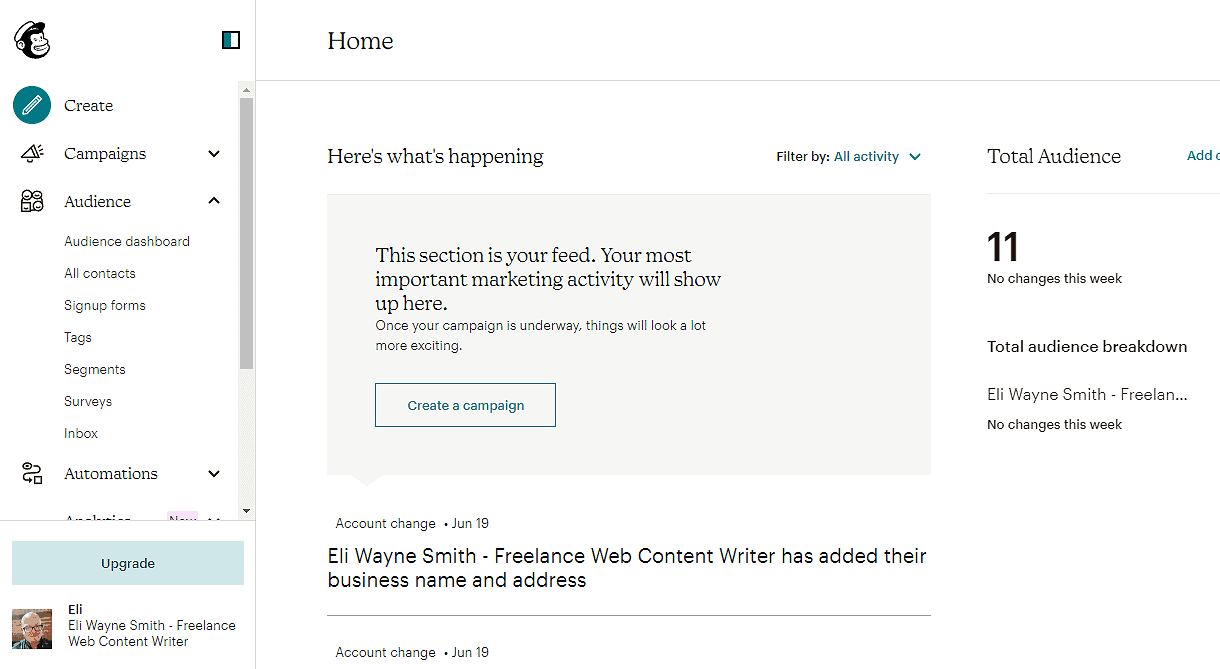
The features behind this product can be broken down into four areas: creation tools, audience management, automation, and analytics. The image above shows the dashboard, giving you a cross-section of everything the company offers.
Using Mailchimp Creation Tools
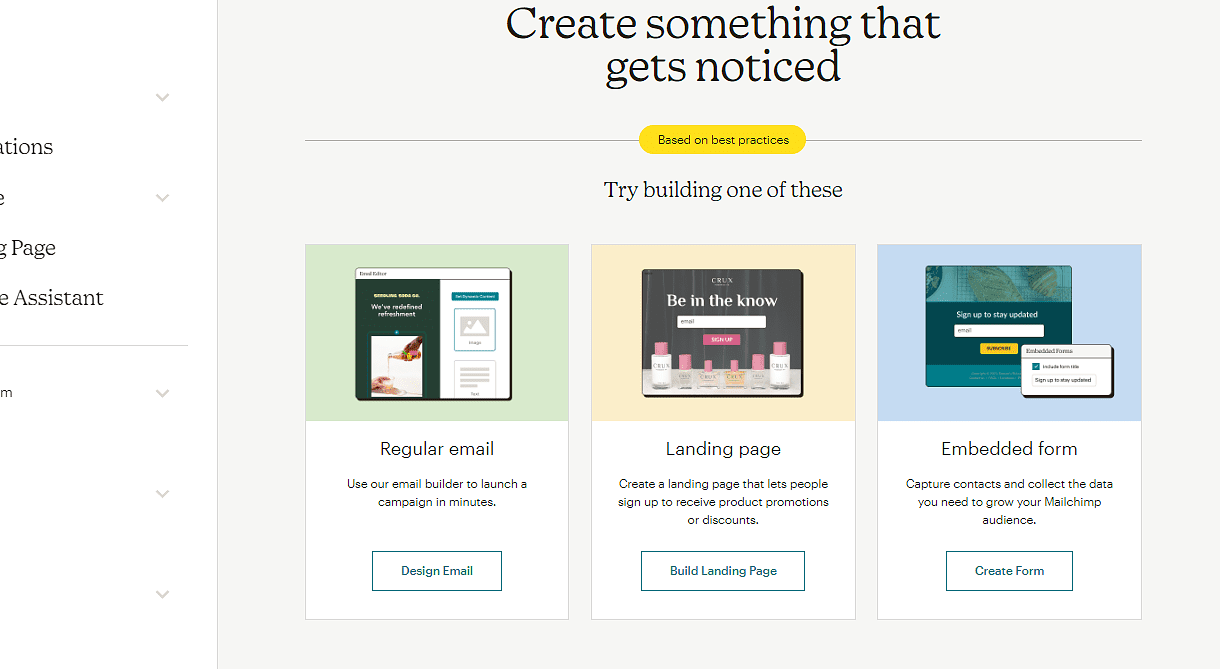
Mailchimp’s creation tools comprise three different areas: email, landing page, and embedded form areas. You can find this by clicking the “create” button in the upper-left corner. You can click “design email” to start with Mailchimp’s most crucial feature.
Creating an email marketing campaign with Mailchimp Email Builder
Clicking the “design email” pulls up your ability to set up the ‘to’, ‘from’, and email ‘subject’ lines. The actual design process can be found by clicking another button that says “design email.”
Clicking this last button pulls up the editing software. Mailchimp is currently demoing a re-designed email builder.
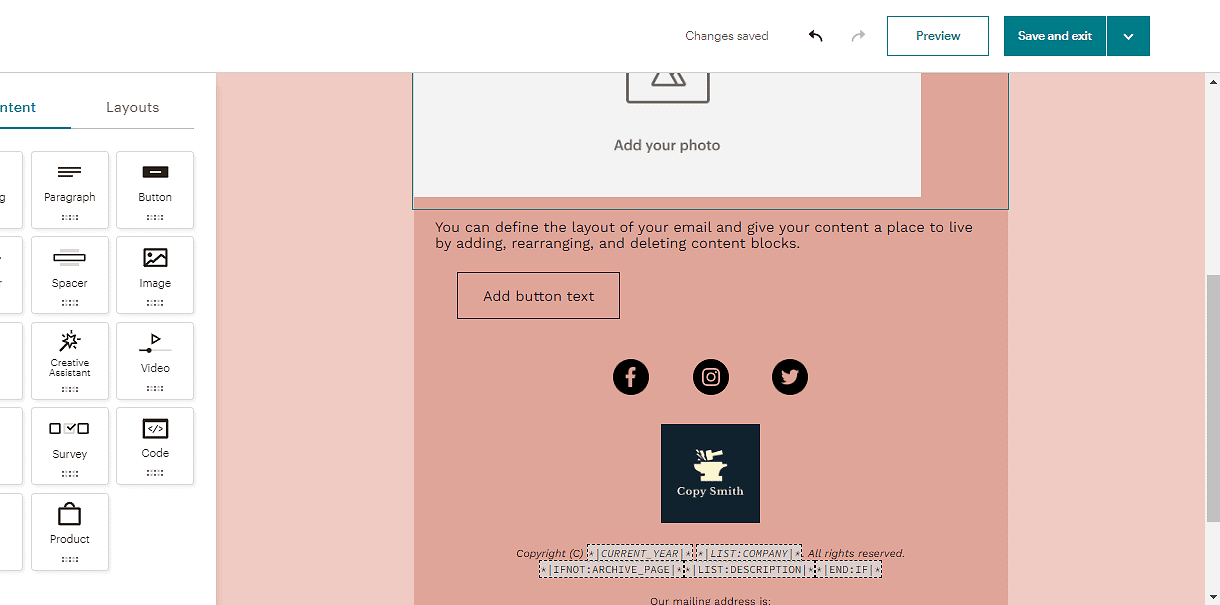
The design tools you get are incredibly simple. The left half of the screen lets you add new elements, change styles, and pick a default template. The right side of the screen shows how your email changes as you adjust the design.
The advantages and disadvantages of Mailchimp’s email builder
The focus on simplicity appeals to most people. You’ll find it similar to competing email marketing software like Sendinblue. However, you might argue that this is too simple, as Mailchimp relies on templates for its designs, which can feel restrictive.
Mailchimp also offers a “creative assistant”, which helps you pick out templates based on the feel you want to go for. It includes plenty of options whether you want to focus on a casual or professional email.
Creating landing pages with Mailchimp Landing Page Builder
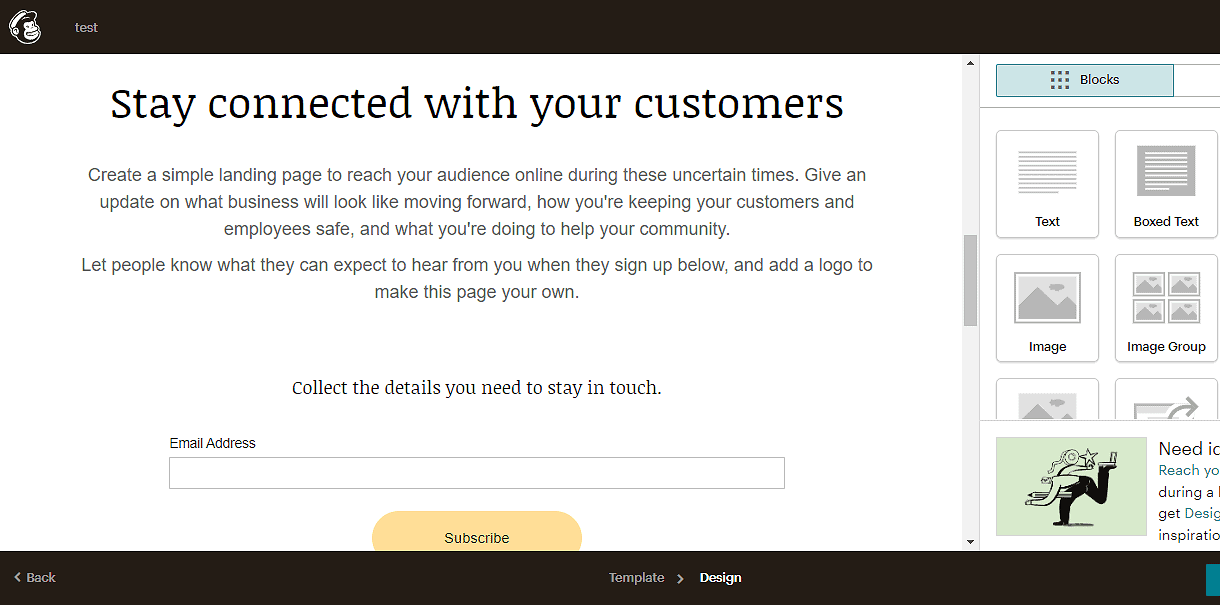
The other half of Mailchimp’s building software is its landing page builder. Contrary to popular belief, the company isn’t just email marketing. Instead, you can build a page for your emails to go to.
Much like the email builder, everything here is template based. This means you won’t find a lot of deep edits. Compared to other landing page builders, this can be frustrating. Those familiar with more dedicated landing page software, like ClickFunnels, will find some hard limits on functionality.
Mailchimp’s paid plans offer simple website hosting. While this is no replacement for hosting a full website you get through Wix or Shopify, it does offer a place for your landing pages. Under the Mailchimp free version, you’ll need to use their domain (mailchimpsites.com) to publish it.
Creating an embedded form using Mailchimp Form Builder

The initial opt-in process is often supported by encouraging people to fill out forms. Mailchimp supports this through its embedded form builder.
Unlike other form builders, there’s no design work here. Instead, you build the forms to be used elsewhere (such as your landing pages). You can also choose to use them on external websites.
The form-building tool is great for growing your list on email or SMS marketing campaigns. You can ask for customer data through the form, allowing them to fill it out in exchange for something of value. This can be a powerful tool to start customer relationships.
Building a full website using Mailchimp Website Builder
When you scroll down on the dashboard, you’ll notice it includes a “website” feature. While Mailchimp isn’t known for its website builder, it is an optional feature you can pay for.
Mailchimp lets you choose between three different site types: eCommerce (creating an online store), service-based (creating an appointment-setting website), or informational. So, there is a lot of opportunity to leverage your website visitors.
You can also integrate your created web forms with your website. So, you don’t have to create a separate website just for a landing page; you can make it part of your current site if you want.
The depth of Mailchimp’s website builder
Those expecting the same depth you get from building a site with Wix or WordPress will be disappointed. Instead, it focuses on those who want a website without all the website-building work. Much like with landing pages, you get a layout, can add more layouts, and can change the style, colors, and design.
Those who don’t expect much from their website builder might find something useful here. However, you’ll want to look elsewhere if you want depth and more customization.
Are Mailchimp’s creative tools useful?
Mailchimp offers a comprehensive list of powerful marketing tools in the email marketing space. All are incredibly useful and work together to build a complete marketing platform.
The user interface of all these builders is incredibly simple and easy to follow. So, if you are a small business that wants an all-in-one solution, Mailchimp offers it.
The one weakness of this is that it’s almost too simple. The drag-and-drop interface has limited elements, which are more apparent under the landing page and website builder. Other building tools have more web page elements available.
Mailchmp Audience Management Tools
Going back to the dashboard, Mailchimp offers some solid audience management tools. You can find these tools under “Campaigns” and “Audience,” so let’s dig into them.
Monitoring your campaigns using Mailchimp
The “Campaigns” tab holds three areas: all campaigns, the Campaign Manager, and email templates. Under “all campaigns,” you can track your active and inactive campaigns.
You can view those campaigns by status (from draft to inactive to complete) and by type (landing pages, social posts, ads, emails, and automation). From here, it’s a campaign-centric view of the results and changes you can make.
Using the campaign manager
The Campaign Manager, which is in beta, gives you a calendar view of your campaigns. This can include multichannel efforts (SMS or email marketing), reports, and optimization data. You’ll need to pay for the standard plan to use it.
By providing a campaign-centric way to view your audience, it becomes easier to use the Mailchimp platform. It also provides a way to view different digital marketing works from a single platform, giving you a holistic look.
Finally, email templates let you save a list of your own templates. This way, you don’t have to rely on Mailchimp’s templates for everything.
Audience-focused management tools
If you prefer to dig deeper into your audience analytics, your Mailchimp account will also support this. Mailchimp lets you sort your audience by the signup forms they fill out and the tags you give them.
All of this sorting lets you drive them through different tracks on the customer journey. You’ll find this incredibly helpful as you start to understand how to send different automated messages.
Here’s a breakdown of worthwhile sections under the audience dashboard:
Audience dashboard breakdown
The “audience dashboard” provides an overall look at what your audience is doing.
“All contacts” let you see different members of your address book
“Signup forms” let you see the results of your forms and provide links to create new ones.
“Tags” lets you track the status of your audience (based on what forms they’ve filled out, whether they’ve bought a product, or how often they respond).
“Segments” lets you track audience members by various criteria (not including what you’ve manually set with tags).
“Surveys” let you create surveys to gather customer data (for example, post-purchase surveys or “where do you hear about us” surveys).
The “inbox” lets you manage one-on-one conversations with your linked emails.
The “loyalty leaderboard” lets you sort customers by their responses to your emails (how often they open them or whether they engage with the links).
This is considered simple data, so it’s made available under the essential plan. This can be incredibly handy when tracking the results of multiple marketing activities.
Mailchimp Audience Analytics Tools

But, regardless of how helpful this simple information can be, a deep dive into the numbers can help. Through Mailchimp’s analytics tools, you can take that deeper dive.
The stat tracked above, engagement, is essential when measuring the click rates compared to the emails sent. Using this data, you’ll be able to identify the effectiveness of your email campaigns using real numbers.
The analytics focus on what’s most valuable. This includes stats based on earnings and responses. If you run an eCommerce store (something you can do without buying another platform), you can track your earnings directly from email marketing.
The big problem with Mailchimp’s analytics
A big part of creating an email marketing campaign is being responsive. Meaning, being able to monitor campaign data over time and make adjustments to improve it accordingly. So, having analytics available only in a higher tier plan can turn off some users.
Even experienced email marketers need data to make their projects work. With this, Mailchimp pushes customers hard to higher-cost plans.
Mailchimp Automation Features
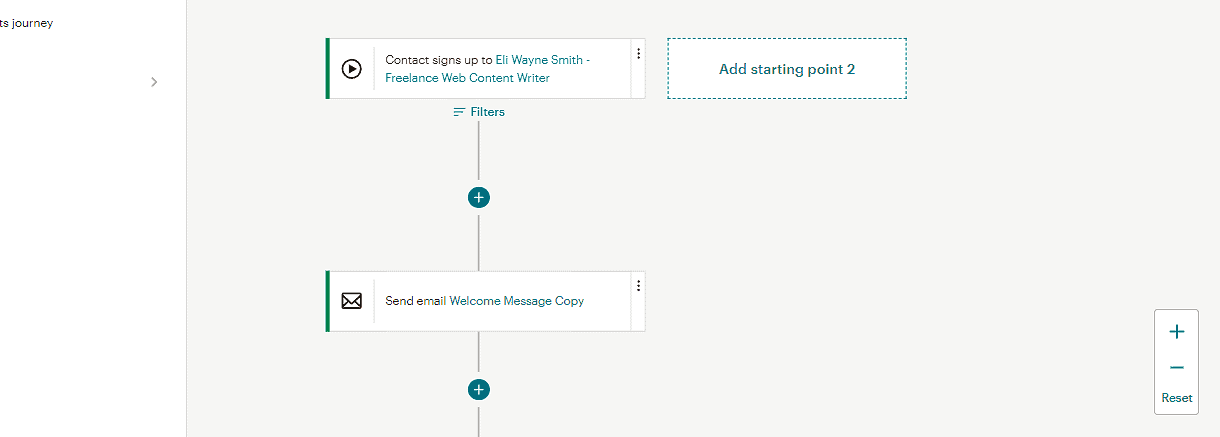
Something that Mailchimp’s free plan doesn’t come with is automation, which is crucial to some email marketing campaigns. Milchimp’s automation is built on two areas: automatic responses and customer journey creations.
Simple automation features
A simple marketing platform and building an email list often start with creating a welcome or response email. Mailchimp’s simple features include creating one-time responses. This welcome can help a new audience member feel appreciated.
Transactional email
Other types of one-time responses include transactional email. For example, order confirmation emails when someone buys a product from your store.
Mailchimp relies on third-party software from Mandrill for transactional emails. But, if you run an eCommerce store or have a high volume of clients, this can be handy.
pre-built customer journeys
Mailchimp also supports pre-built customer journeys. These journeys are based on your goal. For example, you might send new audience members helpful emails about how to do something in their industry.
But to access these pre-built assets, you need to pay for the second-tier standard plan. Otherwise, you can use credits to create a few automated customer journeys.
Creating more complicated Email Automation
The more complex automation features are built into the customer journey builder. Consider it an “if” something happens, “then” something else happens journey.
For example, you might have a series of different follow-up emails based on different customer decisions.
An example of how you can use email automation
One of those decisions could be stating a free trial. At this point, you could send the new trial starter a series of tutorial emails. If they pay, they get the order confirmation email and (possibly) a few extra tutorial emails showing new features.
Alternatively, if they decide against paying beyond the trial, you might ask them for a survey about why. Mailchimp makes this possible through its easy-to-use tool for automation.
The tool is useful because it is a visually-driven email marketing tool. You can see the potential branching paths of the customer journey.
How Mailchimp adds power to your tags
The tool also makes tagging incredibly handy. By adding and reviewing different tags, you identify the customer by their stage in the journey. Connecting this with standard email marketing tactics makes it easier to see the complete picture.
So, you can create a complete customer experience, automated drip campaigns, and anything you can think of. Mailchimp provides one of the most comprehensive marketing tools for automation on the market.
What platforms does Mailchimp integrate with?
Mailchimp brags about having over 300 integrations. Like most email marketing platforms, most of these integrations come from Zapier.
However, Mailchimp is immense, meaning it has more integrations than others. Below is a list of how it integrates by category:
Customer support integrations like LiveChat and SimpleTexting are both found on Mailchimp. These will help you better communicate with customers.
It connects with existing developer tools. For example, you can join it with WordPress for web development or Firebase for app development support.
It connects with social media platforms like LinkedIn and Facebook for lead-generation tactics.
It connects with subscription management systems like Patreon or Recurly.
You can connect it to other survey systems like SurveyMonkey and Formstack.
You import designs from Photoshop, Unsplash, or Canva.
These are some of the more popular integrations. But there are many more for taking payments, improving productivity, or boosting customer support. Mailchimp is truly an all-in-one platform.
Wrap up – Who Is Mailchimp best for?
In this Mailchimp review, there are some pros and cons to the software. The main “con” comes back to cost, as Mailchimp is pricier than competing email marketing tools.
The free version was once pretty lucrative and has been cut down recently. From its long-time users, this might be frustrating. This makes other email platforms more appealing, especially if you want to save money.
But you can’t deny that Mailchimp isn’t good at what it does. After all, it connects marketing newbies with visible solutions. For those willing to pay a bit extra, you’ll find great value here, regardless of your industry.
